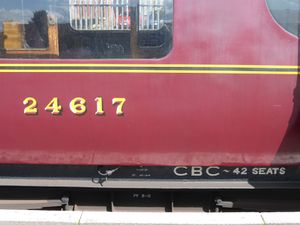Difference between revisions of "Category:BR Carriage classification codes"
(add LMS equivalent codes) |
(Add references) |
||
| (One intermediate revision by one other user not shown) | |||
| Line 19: | Line 19: | ||
==LMS Codes== | ==LMS Codes== | ||
| + | [[File:LMS_Coach_code_20150725.jpg |thumb|300px|right| The LMS coach code and seating capacity is shown on the carriage frame]] | ||
The LMS used a different series of coach codes. The equivalent codes for the LMS carriages on the SVR were as follows<ref>[http://lmsca.org.uk/lms-coaches/lms-coach-codes/ LMS Carriage Association]</ref>: | The LMS used a different series of coach codes. The equivalent codes for the LMS carriages on the SVR were as follows<ref>[http://lmsca.org.uk/lms-coaches/lms-coach-codes/ LMS Carriage Association]</ref>: | ||
{| class="wikitable sortable" | {| class="wikitable sortable" | ||
| Line 42: | Line 43: | ||
==See also== | ==See also== | ||
[[Carriages | List of Carriages]] | [[Carriages | List of Carriages]] | ||
| + | |||
| + | ==References== | ||
| + | <references/> | ||
Latest revision as of 14:07, 19 June 2020
BRBritish Rail or British Railways used a system for identifying carriage types using alphabetical codes, based on that previously used by the LNERLondon & North Eastern Railway. The notes below relate to carriages found on the SVRSevern Valley Railway.
Carriage class and internal layout
For passenger carriages, one letter indicated the class of carriage, normally F (First), S (Second, later Standard), T (Third) or C (CompositeCarriage having more than one class of seating, ie First and Third or latterly First and Standard., ie more than one class). A second letter would indicate the layout, typically O (Open) or K (Corridor). Thus a carriage with Third Class compartments off a corridor would be designated TK.
The letter T when used as a prefix to another carriage class meant ‘Tourist’, indicating 2+2 seating, for example TSO (Tourist Standard Open).
Guard's compartment
The code for carriages including a guard’s compartment would be prefixed by B (Brake), for example BTK. A carriage with a guard’s compartment and a through gangway for passenger access, but with no passenger seating was designated BG (Brake Gangwayed). A specialised form, BGP, indicated a Pigeon-van.
Restaurant carriages
Carriages with catering facilities, or whose principal use was for dining, were normally prefixed R (Restaurant). B as a suffix indicated Buffet. Common forms included RB (Buffet with cooking facilities) and RMB (Restaurant Miniature Buffet, serving snacks).
Other variants
The suffix Z indicated a 6-wheeled vehicle (for example the Barry Railway Composite coach is designated CZ).
Certain letter combinations were entirely descriptive; these included ROY (Royal Coach), INSP (Inspection Saloon), SLEP (Mk 3 Sleeper), GUVGeneral Utility Van, formerly used to transport mail and parcels (General Utility Van) and POS (Post Office Sorting)
LMSLondon Midland & Scottish Railway Codes
The LMSLondon Midland & Scottish Railway used a different series of coach codes. The equivalent codes for the LMSLondon Midland & Scottish Railway carriages on the SVRSevern Valley Railway were as follows[1]:
| Generic type | BRBritish Rail or British Railways Code | LMSLondon Midland & Scottish Railway Code |
|---|---|---|
| Third open | TO | QF |
| Third corridor | TK | CF |
| Third corridor brake | BTK | CH |
| CompositeCarriage having more than one class of seating, ie First and Third or latterly First and Standard. corridor | CK | CBC |
| Passenger rated full brake | BG | CBR |
| 6-wheel passenger rated full brake | BGZ | CR |
| First class open dining | RFO | QL (DINING) |
See also
References
Subcategories
This category has the following 27 subcategories, out of 27 total.
C
- Carriage Type BCK
- Carriage Type BG
- Carriage Type BGP
- Carriage Type BSK
- Carriage Type BSO
- Carriage Type BTK
- Carriage Type BTO
- Carriage Type BY
- Carriage Type CK
- Carriage Type CZ
- Carriage Type FO
- Carriage Type GUV
- Carriage Type INSP
- Carriage Type POS
- Carriage Type RB / RBR
- Carriage Type RC
- Carriage Type RF
- Carriage Type RFO
- Carriage Type RMB
- Carriage Type ROY
- Carriage Type RTO
- Carriage Type SK
- Carriage Type SLE / SLEP
- Carriage Type SLF
- Carriage Type TK
- Carriage Type TO
- Carriage Type TSO
Pages in category ‘BRBritish Rail or British Railways Carriage classification codes’
This category contains only the following page.
